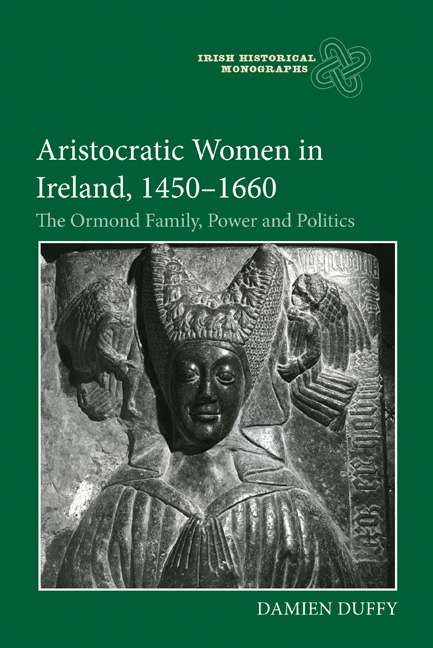Book contents
- Frontmatter
- Dedication
- Contents
- Preface
- Acknowledgements
- List of Abbreviations
- Introduction
- 1 Aristocratic Women’s Lives in Late Medieval and Early Modern Western Europe
- 2 The Ormond Women Through the Wars of the Roses and Immediate Aftermath: Marriage, Absenteeism and Illegitimacy
- 3 New Beginnings: The Heiresses, the Usurper and Royal Intervention – the Succession of Margaret and Anne Butler
- 4 Dynastic Consolidation and Female Political Entity: Margaret Fitzgerald, Countess of Ormond and Ossory (1472–1542)
- 5 Family, Marriage and Politics: The six Daughters of Margaret Fitzgerald and Piers Butler and the Ongoing Revival of the Earldom in the Sixteenth Century
- 6 ‘You have too Piteous a Face to be a Warrior’: Joan Fitzgerald, Countess of Ormond, Ossory and Desmond – Agent, Peace Broker, Advocate
- 7 Black Tom’s Women: Unions, Succession and Decline
- Conclusion
- Bibliography
- Index
- Irish Historical Monographs Previous Volumes
6 - ‘You have too Piteous a Face to be a Warrior’: Joan Fitzgerald, Countess of Ormond, Ossory and Desmond – Agent, Peace Broker, Advocate
Published online by Cambridge University Press: 26 March 2021
- Frontmatter
- Dedication
- Contents
- Preface
- Acknowledgements
- List of Abbreviations
- Introduction
- 1 Aristocratic Women’s Lives in Late Medieval and Early Modern Western Europe
- 2 The Ormond Women Through the Wars of the Roses and Immediate Aftermath: Marriage, Absenteeism and Illegitimacy
- 3 New Beginnings: The Heiresses, the Usurper and Royal Intervention – the Succession of Margaret and Anne Butler
- 4 Dynastic Consolidation and Female Political Entity: Margaret Fitzgerald, Countess of Ormond and Ossory (1472–1542)
- 5 Family, Marriage and Politics: The six Daughters of Margaret Fitzgerald and Piers Butler and the Ongoing Revival of the Earldom in the Sixteenth Century
- 6 ‘You have too Piteous a Face to be a Warrior’: Joan Fitzgerald, Countess of Ormond, Ossory and Desmond – Agent, Peace Broker, Advocate
- 7 Black Tom’s Women: Unions, Succession and Decline
- Conclusion
- Bibliography
- Index
- Irish Historical Monographs Previous Volumes
Summary
Unlike earlier generations, the Ormond women of the mid sixteenth century found themselves at the epicentre of its expansion and indeed its apogee. As attested by the roles of Margaret Fitzgerald and her daughters, and the Kildare and Desmond women, their lives ‘best represent the existence of a coterie of Irish aristocratic families bartering for political control in much the same way as political factions operated for power in the English court’. In Ireland, the coterminous lives of the Kildare, Desmond and Ormond women reveal the political possibilities available to aristocratic women from Old English families. Their families, well positioned in the world of sixteenth-century Irish politics, presented them with such opportunities. On the strength of these women's astute ‘manipulation of the male centred marriage network’, their involvement in guardianship, estate management, and their individual activities in the political sphere show that their lives were not restricted to domestic or familial roles. Joan Fitzgerald, daughter-in-law of Countess Margaret Fitzgerald, took on the role of a powerful and influential woman at the centre of dynastic politics between the houses of Ormond, Desmond and the Crown.
Little is known about Joan's early years, including the year of her birth. She was the only legitimate child and heiress of James Fitzgerald, eleventh earl of Desmond. The earldom in which she grew up was extensive, well developed, and included three cities: Waterford, Cork and Limerick. ‘The Earl of Desmond has lordships and vassals. He has dominions among the wild tribes; he has lords and knights on his estates who pay him tribute. He has ten castles of his own, some of which are strong and well built.’
No account of Joan's life between her father's death in 1529 and her marriage in 1532 exists. As heiress to the deceased earl, the wardship of Joan's body and her inheritance should have gone to the king, yet there is no reference to Joan Fitzgerald until her first marriage. There is uncertainty about ‘whether the wardship of a woman was to endure until she attained the age of twenty-one, or was to cease when she attained the age of fourteen’. What is, however, certain is that ‘marriage with her lord's consent put an end to the wardship of a woman’.
- Type
- Chapter
- Information
- Aristocratic Women in Ireland, 1450-1660The Ormond Family, Power and Politics, pp. 147 - 183Publisher: Boydell & BrewerPrint publication year: 2021

